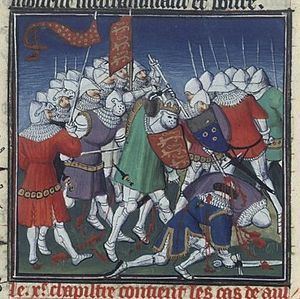Unknown Unknown Date 28 September 1106 | Unknown Unknown | |
 | ||
Similar Battle of Brémule, Battle of Lincoln, The Anarchy, Battle of Mursa Major, Battle of the Standard | ||
Battle of tinchebray
The Battle of Tinchebray (alternate spellings Tinchebrai or Tenchebrai) was fought 28 September 1106, in Tinchebray (today in Orne département of France), Normandy, between an invading force led by King Henry I of England, and his older brother Robert Curthose, the Duke of Normandy. Henry's knights won a decisive victory, capturing Robert and imprisoning him in England (in Devizes Castle) and then Wales until Robert's death (in Cardiff Castle).
Contents
Henry invaded Normandy in 1105, taking Bayeux and Caen. He broke off his campaign because of political problems arising from the Investiture Controversy. With these settled, he returned to Normandy in the spring of 1106. After quickly taking the fortified abbey of Saint-Pierre-sur-Dives (near Falaise), Henry turned south and besieged Tinchebray Castle, on a hill above the town. Tinchebray is on the border of the county of Mortain, in the southwest of Normandy, and was held by William, Count of Mortain, who was one of the few important Norman barons still loyal to Robert. Duke Robert then brought up his forces to break the siege. After some unsuccessful negotiations, Duke Robert decided that a battle in the open was his best option.
Henry's army was organized into three groups. Ranulf of Bayeux, Robert de Beaumont, 1st Earl of Leicester, and William de Warenne, 2nd Earl of Surrey commanded the two primary forces. A reserve, commanded by Elias I of Maine, remained out of sight on the flank. Alan IV, Duke of Brittany, William, Count of Évreux, Ralph of Tosny, Robert of Montfort, and Robert of Grandmesnil also fought with Henry. William, Count of Mortain, and Robert of Bellême, 3rd Earl of Shrewsbury fought with Robert Curthose.
The battle only lasted an hour. Henry dismounted and ordered most of his knights to dismount. This was unusual for Norman battle tactics, and meant the infantry played a decisive role. William, Count of Évreux, charged the front line, with men from Bayeux, Avranches and the Cotentin. Henry's reserve proved decisive. Most of Robert's army was captured or killed. Those captured included Robert, Edgar Atheling (uncle of Henry's wife), and William, Count of Mortain. Robert de Bellême, commanding the Duke's rear guard, led the retreat, saving himself from capture or death. Most of the prisoners were released, but Robert Curthose and William of Mortain spent the rest of their lives in captivity. Robert Curthose had a legitimate son, William Clito, whose claims to the dukedom of Normandy led to several rebellions that continued through the rest of Henry's reign.
Battle of tinchebray
In fiction
The battle is depicted in Rosemary Sutcliff's 1960 historical fiction novel Knight's Fee.
